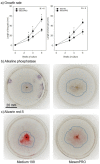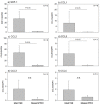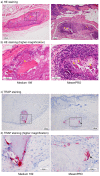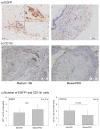Osteoclastogenic Potential of Tissue-Engineered Periosteal Sheet: Effects of Culture Media on the Ability to Recruit Osteoclast Precursors
- PMID: 33671612
- PMCID: PMC7926432
- DOI: 10.3390/ijms22042169
Osteoclastogenic Potential of Tissue-Engineered Periosteal Sheet: Effects of Culture Media on the Ability to Recruit Osteoclast Precursors
Abstract
Cell culture media influence the characteristics of human osteogenic periosteal sheets. We have previously found that a stem cell medium facilitates growth and collagen matrix formation in vitro and osteogenesis in vivo. However, it has not yet been demonstrated which culture medium is superior for osteoclastogenesis, a prerequisite for reconstruction of normal bone metabolic basis. To address this question, we compared chemotaxis and osteoclastogenesis in tissue-engineered periosteal sheets (TPSs) prepared with two types of culture media. Periosteal tissues obtained from adult volunteers were expanded with the conventional Medium 199 or with the stem cell medium, MesenPRO. Hematopoietic enhanced-green-fluorescent-protein (EGFP)-nude mice were prepared by γ-irradiation of Balb/c nu/nu mice and subsequent transplantation of bone marrow cells from CAG-EGFP C57BL/6 mice. TPSs were implanted subcutaneously into the chimeric mice and retrieved after intervals for immunohistopathological examination. EGFP+ cells were similarly recruited to the implantation site in both the TPSs prepared, whereas the distribution of CD11b+ cells was significantly lower in the TPS prepared with the stem cell medium. Instead, osteoclastogenesis was higher in the TPS prepared with the stem cell medium than in the one prepared with the conventional medium. These findings suggest that the stem cell medium is preferable for the preparation of more functional TPSs.
Keywords: CD11b; bone marrow transplantation; green fluorescent protein; osteoclastogenesis; periosteal sheets; tartrate-resistant acid phosphatase.
Conflict of interest statement
The authors declare no conflict of interest.
Figures





Similar articles
-
Tissue culture of human alveolar periosteal sheets using a stem-cell culture medium (MesenPRO-RS™): In vitro expansion of CD146-positive cells and concomitant upregulation of osteogenic potential in vivo.Stem Cell Res. 2013 Jan;10(1):1-19. doi: 10.1016/j.scr.2012.08.006. Epub 2012 Sep 6. Stem Cell Res. 2013. PMID: 23041617
-
Osteogenic activity of human periosteal sheets cultured on salmon collagen-coated ePTFE meshes.J Mater Sci Mater Med. 2010 Feb;21(2):731-9. doi: 10.1007/s10856-009-3896-9. Epub 2009 Oct 16. J Mater Sci Mater Med. 2010. PMID: 19834787
-
Interleukin-3 plays dual roles in osteoclastogenesis by promoting the development of osteoclast progenitors but inhibiting the osteoclastogenic process.Biochem Biophys Res Commun. 2013 Nov 1;440(4):545-50. doi: 10.1016/j.bbrc.2013.09.098. Epub 2013 Oct 5. Biochem Biophys Res Commun. 2013. PMID: 24103757 Free PMC article.
-
M-CSF priming of osteoclast precursors can cause osteoclastogenesis-insensitivity, which can be prevented and overcome on bone.J Cell Physiol. 2015 Jan;230(1):210-25. doi: 10.1002/jcp.24702. J Cell Physiol. 2015. PMID: 24962140
-
Human periosteum-derived cells combined with superporous hydroxyapatite blocks used as an osteogenic bone substitute for periodontal regenerative therapy: an animal implantation study using nude mice.J Periodontol. 2010 Mar;81(3):420-7. doi: 10.1902/jop.2009.090523. J Periodontol. 2010. PMID: 20192869
Cited by
-
Non-destructive, spectrophotometric analysis of the thickness of the cell-multilayered periosteal sheet.Int J Implant Dent. 2022 May 2;8(1):21. doi: 10.1186/s40729-022-00419-1. Int J Implant Dent. 2022. PMID: 35491414 Free PMC article.
References
-
- Okuda K., Yamamiya K., Kawase T., Mizuno H., Ueda M., Yoshie H. Treatment of human infrabony periodontal defects by grafting human cultured periosteum sheets combined with platelet-rich plasma and porous hydroxyapatite granules: Case series. J. Int. Acad. Periodontol. 2009;11:206–213. - PubMed
MeSH terms
Substances
Grants and funding
LinkOut - more resources
Full Text Sources
Other Literature Sources
Research Materials

